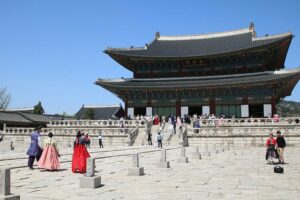With a population of just over 51 million, anyone who’s been to South Korea as a visitor will tell you about the wonders of the country. Its delicious food, rich cultural heritage, modernized cities, and beautiful sights to explore make it a real jewel of the East. For anyone who’s interested in a deeper understanding of South Korea, also known as the “Land of the Morning Calm”, it will be pertinent to examine the name “Korea” itself – its origins and adaptations and what does Korea actually mean.
Gojoseon – 108 BC
Let’s take a look at some history first, and for this we go as far back as 108 BC. This is the period when northern Korea and part of Manchuria were controlled by Gojoseon until, also pronounced as Joseon. The “Go” prefix was attached to the name as it meant “old” or “ancient” and is also used to distinguish it from the time of the Joseon Dynasty that would come later.
Today, North Koreans and Koreans who live in China and Japan use Joseon to refer to the peninsula in addition to the fact that it’s also the official Korean form of the name – Democratic People’s Republic of Korea.
Some scholars believe that the name Joseon was phonetically transcribed from Chinese characters into a native Korean name. Others, on the other hand, believe that it corresponds to certain Chinese references. All while others believe this was a translation of the native Korean Asadal (“asa” meaning “morning” and “dal” meaning “mountain”), which was the capital of Gojoseon at the time.
Han – 7th century
When Gojoseon fell, different chiefdoms in southern Korea began to group into confederacies. These were collectively known as the “Samhan” or “Three Han”. Han, which is the Korean word for “leader”, was later transliterated into Chinese records.
At the start of the 7th century, “Samhan” became synonymous with the Three Kingdoms of Korea and it continued to be a common name to refer to Korea during the Joseon period. This name continued to be used in China and was widely used during the Tang dynasty.
Goryeo – the beginning of the Common Era
Around this time, remnants of the fallen Gojoseon were re-united and expanded by the kingdom of Goguryeo, which was one of the Three Kingdoms. Also a native Korean word was most likely pronounced as “Guri”, and transcribed by various Chinese characters to sound like: Goguryeo, Goryeo), Gori), or Guryeo.
Name revival
The name “Samhan” constituted the Three Kingdoms of Korea after the resolution of Baekje and Silla together with Goguryeo. Then, in 668, Silla unified these kingdoms and reigned until 935.
“Samhan became synonymous with the Three Kingdoms of Korea (7th century) and by the Goryeo period it became a common name to refer to all of Korea.”
The dynasty that followed suit called itself Goryeo or Koryo and saw itself as the successor or Goguryeo (Koguryo). Goryeo – the shortened form of Goguryeo – was first used during the Jangsu reign in the 5th century.
As a result of the Silk Road trade routes, numerous merchants from Persia and the Arab world brought back with themselves knowledge about Silla and Goryeo to the rest of Asia. In addition, Marco Polo transliterated “Goryeo” into “Cauli” (from the Chinese “Gaoli”) when mentioning the country in his travel memoirs.
Then, after a military coup in 1392, the name Joseon was revived (also referred to as Choson). The Chinese translation for this into English was “morning calm or sun”, leading to the adoption of this as Korea’s English nickname.
A couple of centuries later in 1897, Korea was renamed Daehan Jeguk (“Great Han Empire” or the Korean Empire), in order to emphasize the independence of Korea.
20th century and beyond
 In 1910, the Korean empire came under Japanese rule and the country’s name changed back to Joseon, with many groups outside Korea fighting for independence. At the end of World War II in 1945, Korea was divided into North and South parts. In 1948, the South adopted the provisional government’s name of Daehan Minguk or the Republic of Korea, while the North became Chosŏn Minjujuŭi Inmin Konghwaguk, or the Democratic People’s Republic of Korea.
In 1910, the Korean empire came under Japanese rule and the country’s name changed back to Joseon, with many groups outside Korea fighting for independence. At the end of World War II in 1945, Korea was divided into North and South parts. In 1948, the South adopted the provisional government’s name of Daehan Minguk or the Republic of Korea, while the North became Chosŏn Minjujuŭi Inmin Konghwaguk, or the Democratic People’s Republic of Korea.
Modern times
The modern English name “Korea” is an exonym derived from the name Goryeo and is used by both North Korea and South Korea in international contexts. Currently, the two Koreas use different terms to refer to themselves with Chosŏn being used in North Korea and Hanguk in South Korea. Koreans living in China and Japan also use the term Chosŏn to refer to their homeland.
Conclusion
With all this history, it is hoped that you now get some sense of the evolution of South Korea’s name. The Korean language, although formed by a simplified and well-organized alphabet of characters, remains one of the most difficult to learn in the world today. However, if you’re a Korean language learner, the information and history described above should give you a glimpse into the language’s evolution, too and hopefully offer you some explanation of why some Koreans don’t call their country Korea but rather refer to it as Hanguk.